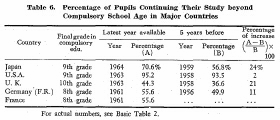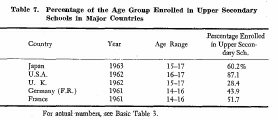| Home > Policy > White Paper, Notice, Announcement > White Paper > EDUCATIONAL STANDARDS IN JAPAN 1965 > CHAPTER1 2 (1) c | ||
The percentage of the age group advancing to post-compulsory education in Japan is considerably lower than the percentage, i.e., 95.2 per cent, in the United States of America, but it exceeds considerably that in each of three other major countries, i.e., the United Kingdom, West Germany and France.
In comparison of the increase in the percentages for the recent five years, the increases in Japan and the United Kingdom are highest followed by that in West Germany. In the United States of America, the percentage was already 93.5 per cent in 1958 and consequently the increase in the percentage was small for the five years period.
In the United Kingdom, West Germany and France, the secondary school was developed as an educational institution for the "elite", and the number of the children continuing their study beyond compulsory education rema ined relatively small. In the post-war years, however, the secondary education system has been democratized and expanded in an effort to attain the educational ideal of "secondary education for all," and the percentage has risen in response to increasing social demand for upper-secondary and higher education.

In Japan, it is estimated, that 60.2 per cent of the population aged 15-17 was enrolled in upper secondary schools in 1963. This percentage is lower than that in the United States of America, but higher than that in the United Kingdom, West Germany and France. In European and American countries, the percentage of those leaving the school in mid-course is considerably higher than that in Japan and the percentage of the enrollment in upper secondary school in the population of the corresponding age is in effect lower than the percentage of the compulsory school graduates entering secondary schools which is indicated in the previous section.

Particularly, in the United Sates of America with the highest percentage of compulsory school graduates entering upper secondary schools, the percentage of those leaving the school in mid-course is also comparatively high and the percentage of those continuing to follow the course for graduation of those who entered high schools remains approximately 75 per cent. The same is true with the United Kingdom and France, but in these countries, to meet the increasing demands of industrialized society for larger numbers of workers who have received education of higher level, various efforts are being made to diversify the curricula for secondary education in accordance with pupils' and students' individual ability and aptitudes as well as to provide financial assistance and guidance for pupils and students with a view to reducing the number of those leaving the school in mid-course.
| Back to Top | MEXT HOME |